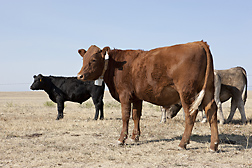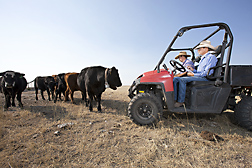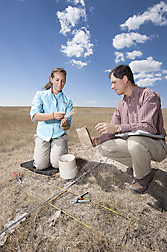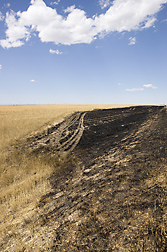Can Livestock, Prairie Dogs, and Fire Coexist?
|
|
Historically, research at the Agricultural Research Service’s Rangeland Resources Research Unit (RRRU) focused on how to manage rangelands of the western Great Plains for sustainable beef production. Wildfires and prairie dogs were considered disturbances to be suppressed. But the unit’s studies in recent years are showing that fire and prairie dogs may be key players in sustaining the biodiversity of the western Great Plains.
As grazers, cattle now perform the historical role of bison on the Great Plains. David Augustine, an ARS ecologist at the RRRU laboratory in Fort Collins, Colorado, and colleagues—in collaboration with state, federal, and university researchers—have results from several studies over the past 13 years showing that fire, prairie dogs, and cattle together maintain a mosaic of diverse vegetation, with varying heights, that supports a variety of wildlife as well as beefing up cattle.
The RRRU is a three-location unit that spans two states—Wyoming and Colorado—and two major native grassland ecosystems of the western Great Plains: northern mixed-grass prairie, where the unit headquarters (High Plains Grasslands Research Station) is located on 2,870 acres near Cheyenne, Wyoming, and shortgrass steppe, where the unit has its 15,500-acre Central Plains Experimental Range (CPER). The CPER is the site of the National Science Foundation’s (NSF) Shortgrass Steppe Long-Term Ecological Research, and NSF grants support part of the ARS research done there. The third location, the Crops Research Laboratory, is in Fort Collins, near Colorado State University (CSU).
Plovers Found on Prairie Dog and Fire Landscapes
Mountain plovers and many other declining populations of grassland wildlife thrive best among low plants, possibly because this enables them to see coyotes, hawks, and other predators. Black-tailed prairie dogs live in the same places, probably because of the same survival instinct. Fortunately, unlike plovers, prairie dogs modify their environment to their benefit: They eat the grasses, making the plants short. And, as they graze, prairie dogs create lots of bare soil, which is key to plover nesting success. The bare soil helps camouflage the brown-colored birds.
But both plovers and prairie dogs can use some help from fire.
Prescribed burns are carefully controlled fires designed to burn safely in a limited area at temperatures that do not damage future plant growth. The burns remove standing dead plant material and increase the exposure of bare soil.
From 2008 to 2009, Augustine surveyed mountain plovers during nesting season in four shortgrass steppe habitats on the USDA Forest Service’s 30-by-60-mile Pawnee National Grassland in northeastern Colorado. Cattle grazed all four sites, and three of the sites had other disturbances—either by fires or by prairie dogs. Augustine found the highest densities of plovers were on the burned sites and among prairie dog colonies.
“We found no plovers on sites lacking recent disturbance by prairie dogs or fire. It turns out that we may need to restore these disturbances because they are an essential part of the grassland’s history and future,” he says.
From 1993 to 2004,Augustine did a broader study with a state agency and two universities that provided more evidence of a link between mountain plovers and grasslands colonized by prairie dogs. The researchers found that when prairie dogs are killed by periodic disease, the number of mountain plover nests goes down quickly. The sites in that study included the Comanche National Grassland, the Central Plains Experimental Range, and mixed-grass prairie on U.S. Bureau of Land Management lands in Montana.
Cows and Ranchers Benefit From Fire Effects as Well
From 1997 to 2002, a period that included dry, intermediate, and wet years, Augustine and CSU researcher Daniel Milchunas studied prescribed burns by the Forest Service on the Pawnee National Grassland. They found that, except after severe drought, prescribed burns done during late winter in grazed shortgrass steppe can have positive effects on livestock. They also found that cattle can graze during the first spring after burning, contrary to the traditional practice of keeping them off rangeland sites the first season after a burn. Also, prescribed burning reduced broom snakeweed infestations for a short time and suppressed prickly pear cactus for one or two seasons. Broom snakeweed is toxic to cattle, and prickly pear can keep cattle from eating forage near it.
|
|
In a 2007 to 2008 Pawnee study, Augustine, Milchunas, and Justin Derner, rangeland scientist and research leader for the unit, found that prescribed burning substantially increased soil nitrogen availability to plants in the first summer after burning. Augustine says, “It also significantly enhanced the digestibility of blue grama in late May, when cattle typically begin summer grazing on shortgrass steppe.”
Both studies indicate that under most weather conditions, late-winter burns in previously grazed shortgrass steppe do not reduce forage growth.
“It has long been thought that burning is harmful to rangeland during dry years,” Augustine says, “and that may be true for sagebrush steppe found farther west. But we did not find that true for the shortgrass steppe found in Colorado.”
Worldwide, shortgrass steppe is one of the rangeland types most resistant to grazing and fire disturbances. Derner says, “This may be due in large part to the traits of the dominant perennial shortgrasses: blue grama and buffalo grass. Blue grama’s abundant underground growth and buffalo grass’s prostrate growth make them very resistant to aboveground disturbances. The combination of resistant plants and a conservative stocking rate in our study may be why we didn’t find any negative effects.”
All of this goes to show that science can help ranchers determine the best course of action to achieve their goals, especially in regard to sensitive issues.—By Don Comis, Agricultural Research Service Information Staff.
This research is part of Pasture, Forage, and Range Land Systems, an ARS national program (#215) described at www.nps.ars.usda.gov.
David Augustine is with the USDA-ARS Crops Research Laboratory, 1701 Center Ave., Fort Collins, CO 80526; (970) 492-7125.
Justin D. Derner is with the USDA-ARS High Plains Grasslands Research Station, 8408 Hildreth Rd., Cheyenne, WY 82009-8899; (307) 772-2433 ext. 113.
"Can Livestock, Prairie Dogs, and Fire Coexist?" was published in the March 2011 issue of Agricultural Research magazine.










